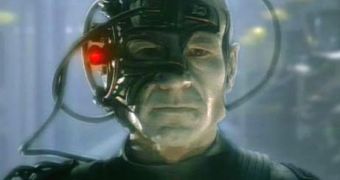Retinal implants that can restore vision, or improve the existing one, by taking over the job of turning light into signals transmitted to the brain, have been made famous by sci-fi productions.
Among the celebrities, Star Trek character Geordi La Forge, that used such an implant to replace his lost sight, but also to offer him a unique electromagnetic view of the world, or the Borg nation, biological beings artificially enhanced by a robotic queens, invariably wore eye implants.
So far, about 10 people in Germany and 15 in the US have been fitted with such implants although expanded US trials are planned.
"These people report seeing light and dark and maybe some limited fuzzy shapes," says Rolf Eckmiller, a computer scientist at Bonn University in Germany. "But they don't have any gestalt perception."
The secret to improving these implants is to match the signals they produce with the signals that a healthy eye sends to the brain. One team in California, US, is trying to do that by building a copy of the retina's neurons in silicon. Eckmiller, along with colleagues Oliver Baruth and Rolf Schatten, plan to use learning software instead.
A camera feeds information to a "retina encoder" - software that mimics the image processing done by a healthy retina. "It has hundreds of different parameters [that can] be properly tuned," says Eckmiller. "But only one setting is appropriate to allow proper perception."
The newly developed software actually adapts to the user by learning the correct settings from him, through a "dialogue module" that tries different settings while a user looks at standard shapes. The user selects the three settings that most closely match the real shape and the software then presents six more settings based on these three.
In time, the system learns to produce a signal that provides a more accurate picture to the user's brain.
The wearer also controls the systems through motion sensors attached to the visor that detected changes in the position of the head and the direction of sight.
Successive rounds of the process can transform an almost shapeless collection of dots into a recognizable replica of the shape. Eckmiller now intends to start testing the training system on people with real implants.
The issue of exactly reproducing the signals the brain normally uses is not currently a high priority for the field, instead the biggest challenge is to make a working device that interfaces with neurons properly.
Applications need some refining, since for now trials on human subjects have been limited, about 50 of them have been performed on sighted people, but continuous efforts are made to effectively design high performance visual implants.

 14 DAY TRIAL //
14 DAY TRIAL //